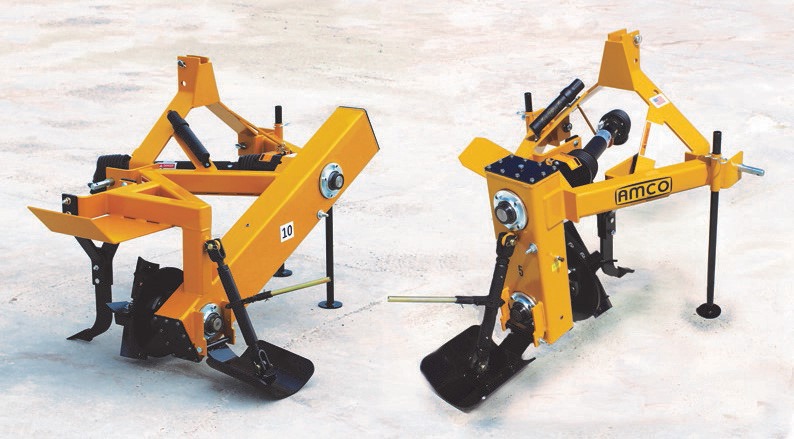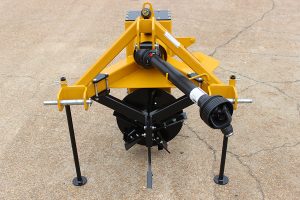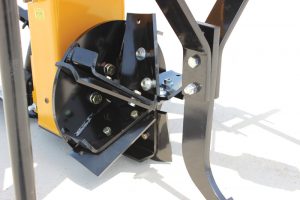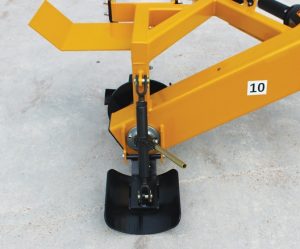
AMCO ditchers feature a powder-coated finish, which is both highly durable and environmentally friendly.
Conditions are currently a mixed bag across the United States. There has been serious flooding this year in California and Florida, and parts of the Midwest are on watch as the waters of the Mississippi River rise.1 Meanwhile, other areas of the country remain in drought conditions.2

The new Dominator Vertical Rotary Ditcher can be used with larger tractors with horsepower in the 80–200 range.
But spring is here, which means now is the time to start cleaning roadside ditches and directing water away from your fields (especially if you live in an area that’s been hit hard with heavy rain). In other words, it’s time to break out your AMCO Vertical or Offset Rotary Ditcher.
A well-built drainage system sets you up for success, and AMCO’s ditchers are known for their toughness and reliability. The Offset Ditcher, in particular, offers outstanding performance in wet conditions. Its cutter head sits behind the left tractor tire, leaving only the right tire track alongside the ditch. That means there’s no need to straddle the ditch to clean it out—you just need to drop one tire in and go.
Whether you’re using a Vertical or Offset model this season, before you break out your AMCO ditcher make sure you’re maximizing its full potential by following these hitching and operating guidelines.
HITCHING THE DITCHER
- Before backing the tractor in front of the ditcher, check the PTO shaft travel. It should slide forward freely without bottoming out.
- Lubricate the PTO shaft.
- Check the shear bolt.
- Make sure the tractor drawbar is moved to one side, retracted, or removed. Do not leave the drawbar in the middle of the tractor. That may cause damage to the PTO shaft.
- AMCO ditchers will fit category II and III three-point hitches or category II couplers. Connect the three tractor lift links to the ditcher with the connecting pins. The ditcher PTO shaft should be connected to the tractor PTO shaft by sliding the ditcher shaft forward until the quick disconnect pin slips into the groove on the tractor shaft. Use caution—the universal drive shaft could slip off the tractor PTO if the quick disconnect pin isn’t securely connected.
- Pin the parking stands in the raised position. Slowly raise and lower the ditcher to check its drive shaft length. At least 6″ of the shaft should be engaged in the tubular portion of the universal shaft drive. Check the shaft drive in the fully retracted position to make sure it will turn freely. Also check the drive shaft to make sure it won’t hit the tractor drawbar.
- Extend or retract the tractor’s top lift link until the chain case is vertical when lowered to the normal operating position. Also make sure the universal drive shaft has an equal offset in each joint.
CAUTION: If you notice that parts of the ditcher need to be lubricated or repaired before operation, disengage the tractor’s PTO and wait for the cutter head and cutting blades to come to a complete stop. Then, slowly lower the ditcher until the skid shoe touches the ground. Before dismounting, shut off the engine, set the parking brake, and remove the key.
 Did You Know? Our cutter heads feature five heat-treated blades that are replaceable. The cutter head width is adjustable from 18″ to 20″ or from 24″ to 26″.
Did You Know? Our cutter heads feature five heat-treated blades that are replaceable. The cutter head width is adjustable from 18″ to 20″ or from 24″ to 26″.

The concave skid shoe with quick-adjust ratchet gives better tracking for a more uniform ditch. It is standard on all AMCO ditcher models.
OPERATING THE DITCHER
- Before engaging the PTO, make sure the cutter head and cutting blades aren’t making contact with the soil.
- After the cutter head has started rotating, set the engine speed for 540 or 1,000 RPM. Never operate the ditcher above its RPM rating; excessive PTO speed can cause personal injury and damage the equipment.
- Start the forward motion of the tractor and lower the ditcher into the ground.
- If available, use the float position on the tractor’s three-point lift. This feature will allow the skid shoe to control the depth of the cut.
- Slowly move the tractor forward while lowering the ditcher until it reaches the desired working depth. Base forward speed and depth on the soil condition.
- Raise the ditcher to clear the soil surface before making sharp turns or backing up. Never raise the ditcher to maximum height with the PTO engaged.
AMCO ditchers can help you handle the conditions Mother Nature throws your way. For more instructions on using and taking care of your AMCO ditcher, review the operating manual or contact an AMCO tough tillage expert.
Visit the Vertical and Offset Rotary Ditchers page on our website to learn more about AMCO’s industry-leading tools.
1. https://apnews.com/article/mississippi-river-flooding-iowa-illinois-c5f8b1f2e9e0b83e46123470e21dd5d7
2. https://droughtmonitor.unl.edu/ConditionsOutlooks/CurrentConditions.asp